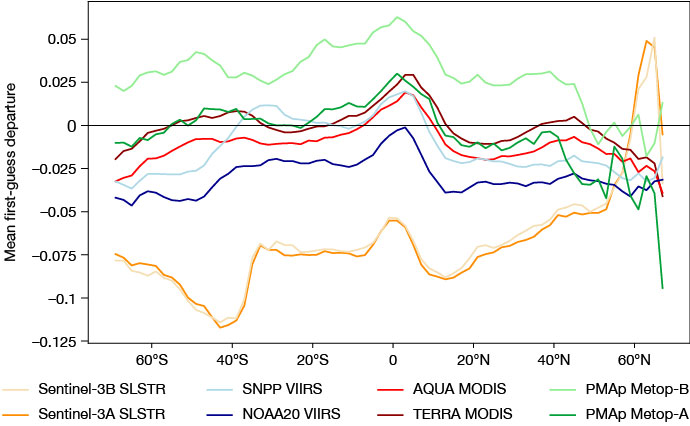Satellite aerosol optical depth (AOD) observations, which measure the extinction of light by aerosols from the surface to the top of the atmosphere, are used to constrain the initial conditions of global aerosol forecasts through data assimilation. Most global aerosol data assimilation systems have been relying on the Moderate Resolution Imaging Spectroradiometer (MODIS) instruments onboard the NASA EOS Aqua and Terra satellite platforms, which have been providing AOD over land and ocean since 2000. However, the retrieval of AOD from satellite radiances is a challenging task due to the weak aerosol signal, which needs to be separated from larger cloud and surface reflectances and can be affected by various sources of uncertainties.
The EU-funded Copernicus Atmosphere Monitoring Service (CAMS) implemented by ECMWF provides global reanalysis and 5‑day global forecasts of aerosols by using the COMPO configuration of ECMWF’s Integrated Forecasting System (IFS) and its 4D‑Var data assimilation scheme. For this purpose, near-real-time (NRT) AOD observations from MODIS and PMAp (a product provided by EUMETSAT exploiting the synergy between multiple instruments onboard the Metop satellites) are operationally assimilated in the COMPO suite. Implementing new satellite AOD observations is an important aspect of the IFS development within CAMS to maximise the spatial and temporal coverage of the assimilated observations, to enhance the accuracy of the analysis, and to increase the resilience of the data assimilation system against instrument failures or disruption (e.g. loss of MODIS). Here we report on monitoring two new NRT AOD products in preparation for their future assimilation in the IFS: one from the SLSTR instrument onboard the Sentinel‑3 satellites (Collection 1), produced by EUMETSAT, and one from the VIIRS instrument onboard the SNPP and NOAA20 satellites (v2r1), produced by the US National Oceanic and Atmospheric Administration (NOAA).
Experiment design and methodology
The experiment was run for the period 1 December 2019 to 30 May 2020 using the operational COMPO configuration. VIIRS and SLSTR AOD observations were passively monitored while MODIS was assimilated over land and ocean and PMAp was assimilated over the ocean. The diversity between the AOD retrievals is investigated by looking at systematic and random differences between the satellite observations and their model-simulated equivalent.
Sources of differences between AOD retrievals
The figure shows the latitude cross section over the ocean of the mean first-guess departures, which represent the differences between the satellite AOD values and the model-simulated values based on short-range forecasts. The main sources of diversity between retrievals over the ocean background aerosol, which is generally characterised by a low aerosol burden, arise from uncertainties in cloud detection, radiometric calibration and the ocean surface reflectance models used in the retrieval algorithms. For instance, the very stringent cloud mask used in the SLSTR product explains part of the significantly smaller AOD values of SLSTR at the model grid spatial resolution compared to the rest of the products. Geometry characteristics of the instrument (swath, spatial resolution, view angle), which drive the range of scattering angles sampled by the instrument, can also explain an important part of the differences between retrievals, such as the positive offset between PMAp from Metop‑B and Metop‑A. Uncertainties in the radiometric calibration represent a major source of differences between retrievals from the same instrument onboard different platforms. This is shown by the positive offset over the ocean between TERRA/MODIS and AQUA/MODIS retrievals due to the uncorrected radiometric calibration degradation of TERRA/MODIS, and between SNPP/VIIRS and NOAA20/VIIRS retrievals related to the positive bias in the solar reflective bands of SNPP/VIIRS. Finally, the figure shows that VIIRS AOD is lower than MODIS over the ocean, which can be related to differences in instrument geometry, cloud filtering and radiometric calibration.

Implications for data assimilation
The assessment of the AOD product characteristics within the CAMS data assimilation system provides meaningful information to implement an accurate multi-satellite AOD data assimilation system. While the magnitude of the mean deviations between retrievals is relatively small over the ocean (and certainly much smaller than over land), the low AOD value of the ocean background aerosol means that a slight difference in mean AOD values between products will have a significant impact on the data assimilation. For instance, since VIIRS has lower values than MODIS over the ocean, its assimilation will likely decrease the analysis values over the ocean, which are currently known to be too high due to the positive offset of TERRA/MODIS, if no bias correction is applied. Therefore, a careful assessment of the departures between products retrieved from different instruments or different platforms informs how bias correction needs to be applied within the system. For instance, the monitoring results suggest that it would be preferable to use NOAA20/VIIRS as an anchor and apply bias correction to SNPP/VIIRS. The results also highlight the role of geometry in retrieval uncertainties that can lead to systematic differences between products. Adding the scattering angle in the current variational bias correction scheme implemented in the CAMS data assimilation system could help to represent any geometry-dependent biases in the retrieval.
Feedback to space agencies
Another important use of the described monitoring experiment with various satellite AOD products is to provide feedback to data providers. This can be used to improve the AOD retrievals themselves. The monitoring of multi-satellite AOD observations within the IFS COMPO configuration enabled us to identify initial issues with the SLSTR Collection 1 product, which shows much lower values than the rest of the satellite retrievals and the model background. This was reported back to EUMETSAT, who confirmed that the original stringent cloud mask applied to SLSTR radiances is inappropriate for aerosol retrievals. EUMETSAT is now preparing a new collection of SLSTR AOD observations over the ocean with a new cloud and aerosol detection algorithm, which will then go through the same assessment as described above with the aim to operationally assimilate the product in the near future.

